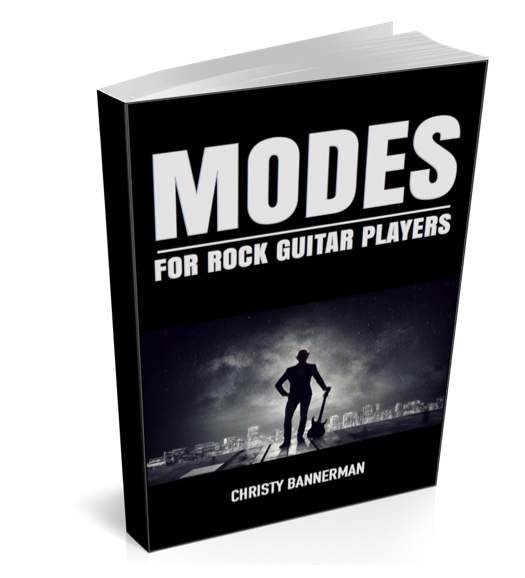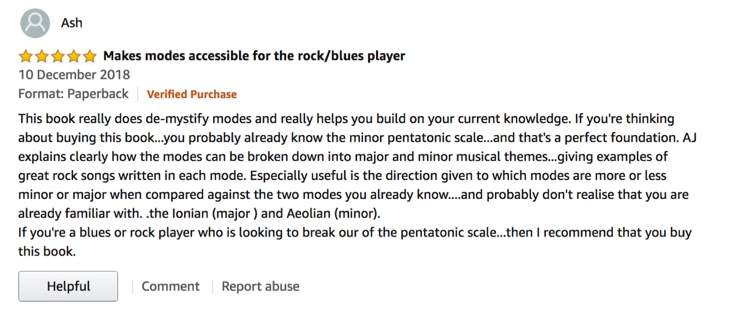The Modes…
The keys to the musical Ferrari. The secret knowledge of guitar virtuosos. The Holy Grail of being able to play anything you want.
You’re here because you’ve heard guitar players talking about something called “Modes”, but you still don’t understand what they are, how to play them, or where to use them in your own playing.
You’ve tried to learn them, but it's so confusing
Teachers say things like “If we start a C major scale from the D note, then that’s the Dorian Mode”, or “D Dorian is the same as E Phrygian”, but what does any of that mean? How do you actually use them?
You’re not alone – I got nowhere with understanding Modes for many years too. There’s a lot of confusion and bad information out there.
Let’s bust some of the myths you might have heard about the Modes
Myth #1 – Modes are exotic, unusual or rare
Modes are extremely common, and are heard all the time in almost every style of music. Modes can be used to evoke particularly exotic or unusual sounds, but you’ve probably already heard most or all of the Modes before in normal everyday music.
Myth #2 – Rock and Blues music is too simple to use Modes
That’s not the case at all. Modes are everywhere in Rock music. Let me give you a few examples:
Some of the most popular rock songs of all time, like “Sweet Home Alabama” by Lynyrd Skynyrd and “Sweet Child O Mine” by Guns n Roses both use the Mixolydian Mode (and Sweet Child O Mine changes mode to Aeolian halfway through). Hendrix is fusing the sound of Mixolydian and Dorian together in “Red House”. “Wherever I May Roam” by Metallica uses the Phrygian Mode, and 80’s Rock legends like Van Halen and George Lynch are using Dorian all over their solos. You’ve also heard the otherworldly Lydian Mode before, from dreamy Pink Floyd to the futuristic alien sound of Joe Satriani and Steve Vai. If you’re a fan of Heavy Metal you might have heard the harsh dissonance exemplified by the Locrian Mode. If you want to play Rock and Blues, then NOT knowing about Modes is like hearing and playing in black and white vs full colour.
Myth #3 – Modes are only for advanced players
It’s actually the other way around – understanding Modes is a necessary part of becoming an advanced player, both musically and technically. You can’t get advanced until you understand Modes. You can use and apply Modes in really cool ways even if you are not a very technical player yet, and in the process of learning them you improve every aspect your playing, including your technique.
Myth #4 – Modes are complicated and hard to learn
Learning to play a Mode is actually no harder than learning a scale like the Minor Pentatonic or Blues scale. It’s the way Modes are usually taught that makes things so hard and confusing for so many people, and much of this confusion is caused by the next myth…
Myth #5 – Modes are a completely different thing from Scales
Instead of showing you what Modes are, a lot people start off by telling you that they’re not scales. But that’s not helpful, and just adds more confusion. What is a scale in the first place? A scale is a set of notes that produce a particular musical mood when used together. That’s all Modes are too. In practice Scales and Modes are the same thing. There is a technical difference between the two, but it’s academic, and it’s not required to start learning Modes. And the really dumb thing about trying to learn them like this is that in order to understand the difference, you would need to already understand Modes anyway… so, when it’s approached like this, it’s no wonder most people get hopelessly confused!
The truth? Modes ARE just like Scales
Let’s cut through all the mythology and esoteric BS that does nothing except confuse people, and break things down. There are 7 Modes — that means 7 scales to learn. You just need to learn 7 scales. That’s all there is to it, and that’s all you need to do. You can totally do that. Despite what you might’ve thought in the past, there’s no mystery or magic or dark arts involved.
And they’re EASY if you take the right approach
The really cool thing is that you don’t even need to do that – it’s actually easier than learning 7 new scales. You see, the 7 Modes are NOT 7 totally different scales. They divide into two basic groups, and the Modes within each group are so similar to each other that the difference between them is only one or two notes. This means that as soon as you have learned even a couple of key Modes in the right way, it’s easy to learn all the others.
Learning the Modes doesn’t need to be a struggle if it’s approached in the right way.
Finally… the answers you’ve been searching for

I have created Modes for Rock Guitar Players to show you the fastest and most effective way to learn the Modes. Modes For Rock Guitar Players is not a few cheap tricks or hacks, or a bunch of scale diagrams like you might have seen before. This isn’t the same as what you can find anywhere else. What you get here is a complete system for understanding and mastering the Modes, which is simple and easy to follow no matter how long you’ve been playing, and which you can immediately start to use in your own playing straight away. It’s been designed especially for rock players just like you, and it works.
In Modes For Rock Guitar Players I am going to show you step-by-step how to:
1: Learn the Modes in the best way for playing Rock and Blues
There is more than one way to approach learning Modes, and some are more effective than others. It’s vital to learn the Modes in a way that fits together and builds on what you already do — otherwise you’ll find that you simply get stuck between two different “settings” of Rock/Blues Playing and Modal Playing. This is a VERY common trap to fall into. Everything should integrate fully together, so that you find it effortless to transition between Pentatonic playing and Modal playing, or totally blend them in any way you like. That’s exactly what you will get with this system.
2: Finally understand what your favourite players are actually doing
You’re told by most teachers that Rock solos just use the Pentatonic Scale… but when you actually look up solos you want to learn, you see they’re constantly using notes “outside” the standard Pentatonic Scale, even in classic rock era solos. This isn’t something reserved to virtuoso players like Joe Satriani — players like Hendrix, Clapton, Angus Young and Slash are doing it all the time too. What are all these “extra” notes, and why are they being used when they are? It’s all to do with Modes. Now you’ll no longer be in the dark about what’s going on, and you will be able to learn from your favourite players in a way like never before.
3: Understand when and where to use each Mode in your own playing
You can learn how to play the Modes, but that doesn’t mean you can just play any Mode you feel like at any time. You need to understand which Modes fit with what kind of chords and progressions you’ll be playing over, otherwise there’s no point in even knowing them. This essential information is often completely overlooked, but in this course you will learn an easy method to match Modes with songs, so that you can actually use your knowledge musically and effectively.
4: Add extra expression and flavour to your soloing and improvising
The pentatonic and blues scales are staples for good reason – they’re incredibly versatile, and they sound great. Even so, if you’re anything like most guitar players, you’ll reach a point where you just want to change things up and be able to do something different. You’ll also find musical situations where these scales either just don’t fit, or they seem to be ‘lacking’ something. As soon as you start learning Modes, you’ll start to imagine new ideas and see all sorts of new possibilities opening up. Once you’ve mastered them, you’ll be able to create any kind of sound you want.
5: Easily transform your favourite rock licks into exotic ‘modal’ licks
One of the most common problems people encounter is that they start trying to learn Modes in a way that’s completely counter-intuitive to rock and blues playing. Everything you already know – like your favourite licks and phrases – goes out of the window, and you have to get used to a whole new style of playing. Not with this method. With this method you’ll discover how easy it actually is to make small tweaks to any rock or blues licks and utterly change their sound. With this method your licks will sound Modal, but they will also Rock!
Here’s what you WON’T find in this book
- Bullshit and timewasting
- Myths and misinformation
- Superficial shortcuts that are useless in real-life
- Tedious and overlong explanations, full of dense jargon and academic talk
- Assumptions that you already know tonnes of music theory
- Examples of music you haven’t heard, don’t play, and don’t care about
Here’s what you WILL find in Modes For Rock Guitar Players:
- A simple and logical step-by-step method to learn all of the Modes
- The best way to visualise the Modes for playing Rock, Blues and Metal
- Clear plain language that’s easy to read and fast to review
- Practical knowledge that you can start using today and getting results with immediately
- The things you need to know, and none of the things you don’t
- 100% accurate tab and scale diagrams
- Extensive examples of Modes being used by the greatest Rock, Blues and Metal bands



End a lifetime of confusion and frustration today for only $9.99
Ebook version $9.99, Paperback version $19.49
